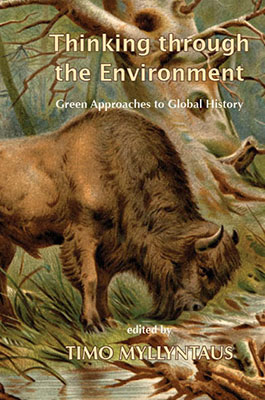Thinking Through the Environment
Green Approaches to Global History

Timo Myllyntaus (ed.)
Thinking through the Environment: Green Approaches to Global History is a collection offering global perspectives on the intersections of mind and environment across a variety of discourses – from history and politics to the visual arts and architecture. Its geographical coverage extends to locations in Africa, Asia, Australia, Europe and North America. A primary aim of the volume is, through the presentation of research cases, to gather an appropriate methodological arsenal for the study of environmental history. Among its concerns are interdisciplinarity, eco-biography, the relationship of political and environmental history and culturally varied interpretations and appreciations of space – from Bangladesh to the Australian outback. The approaches of the indigenous peoples of Lapland, Mount Kilimanjaro and elsewhere to their environments are scrutinised in several chapters. Balancing survival – both in terms of resource exploitation and of response to natural catastrophes – and environmental protection is shown to be an issue for more and less developed societies, as illustrated by chapters on Sami reindeer herding, Sudanese cattle husbandry and flooding and water resource-use in several parts of Europe. As the title suggests, the volume exposes the lenses – tinted by culture and history – through which humans consider environments; and also foregrounds the importance of rigorous ‘thinking through’ of the lessons of environmental history and the challenges of the environmental future.
 | We are pleased to announce that Thinking Through the Environment has been accepted for indexing in Thomson Reuters Web of Science Book Citation Index. |
LOOK INSIDE THIS BOOK at Amazon.co.uk
THE EDITOR
The editor, Timo Myllyntaus, is Professor of Finnish history at the University of Turku, Finland. His articles on environmental history deal with forest, water and climate history as well Finnish historiography. He co-edited Encountering the Past in Nature, Essays in Environmental History (2001) and the anthology Pathbreakers, Small European Countries Responding to Globalisation and De-globalisation (2008).
‘… offers much food for thought’
Douglas Weiner – Environmental History
‘ … will appeal to many who work for ecological restoration in both university life and public life’
Richard Tucker – Environment and History
CONTENTS
Preface, Timo Myllyntaus
Part I. Approaching the Environment of the Past
Chapter 1, Fiona Watson
Interdisciplinarity as Disciplinary Co-operation: A Plea for the Future of Environmental History
Chapter 2, Donald Worster
Biography and Environmental History
Chapter 3, Frank Uekoetter
The Nazis and the Environment – a Relevant Topic?
Part II. Cultural Perceptions of Landscapes
Chapter 4, Dilshad Rahat Ara
The Space of a Dwelling – the Temporal Boundaries of Vernacular Architecture in the Chittagong Hills, Bangladesh
Chapter 5, Libby Robin
Art and Environmental History: Perceptions of Place and Deep Time in the Australian Desert
Chapter 6, Anu Eskonheimo
Desertification – A Significant Problem? Diverse Environmental Literacy in the North Kordofan Area of Sudan
Chapter 7, Timothy Clack
Thinking Through Memoryscapes: Symbolic Environmental Potency on Mount Kilimanjaro, Tanzania
Chapter 8, Leena Rossi
Oral History and Individual Environmental Experiences
Part III. Indigenous Peoples and the Pressures of Modernisation
Chapter 9, Helena Ruotsala
Ancestors’ Wisdom or Desktop Reindeer Management? The Role of Traditional Ecological Knowledge in Contemporary Reindeer Herding
Chapter 10, Jukka Nyyssoenen
Identity Politics and the Alliance Building between the Sami Parliament and Conservationists in the Kessi Forest Dispute
Part IV. Managing Flood Catastrophes
Chapter 11, Jochen Seidel, Paul Dostal, Katrin Bürger, Florain Imbery and Mariano Barriendos
Analysis and Reconstruction of the Flood Catastrophe along the River Neckar (SW-Germany) in October 1824
Chapter 12, Guido Poliwoda
Times of Flood – Times of Favour. Disaster Management and the Social Response to Catastrophic Floods: the Example of Saxony (1784-1845)
Part V. Remoulding Rivers, Reshaping Societies
Chapter 13, Erik Törnlund
From Natural to Modified Rivers and Back? Timber Floating in Northern Sweden in 1850-1980 and the Use of Historical Knowledge in Today’s Ecological Stream Restoration
Chapter 14, Viktor Pal
To Act or Not to Act: Water Problems in North-east Hungary after 1945
20th June 2011, 320pp.
ISBN 13 978-1-874267-62-1 (HB) £65
ISBN 13 978-1-874267-71-3 (PB) £28
